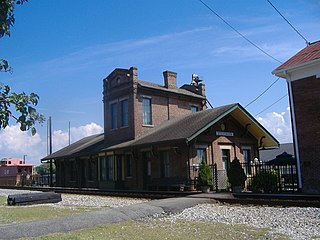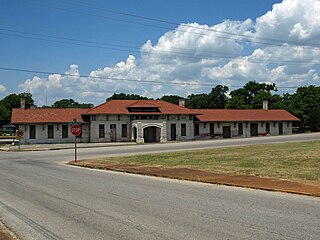
Scottsboro is a city in and the county seat of Jackson County, Alabama, United States. The city was named for its founder Robert T. Scott. As of the 2020 census, the population of the city is 15,578.

Stevenson is a city in Jackson County, Alabama, United States, and is included in the Chattanooga-Cleveland-Dalton, TN-GA-AL Combined Statistical Area. Sources listed either 1866 or 1867 as the year of incorporation, but that seems to conflict with the dates given for the town being granted a charter. It did not first appear on the U.S. Census until 1880, where it was the second largest town in Jackson County behind Scottsboro. Since 1900, it has been the third largest town behind either Scottsboro and Bridgeport or vice versa. At the 2020 census, the population of the city was 1,955, down from 2,046 in 2010.

The Huntsville Depot located on the Norfolk Southern Railway line in downtown Huntsville is the oldest surviving railroad depot in Alabama and one of the oldest in the United States. Completed in 1860, the depot served as eastern division headquarters for the Memphis and Charleston Railroad. It is listed on both the Alabama Register of Landmarks and Heritage and National Register of Historic Places.

The Old Gainesville Depot is a historic site at 203 Southeast Depot Avenue in Gainesville, Florida. It is located along the Gainesville-Hawthorne Trail State Park.

Oklahoma City Union Depot is a building in Oklahoma City, Oklahoma that served as a "union station" from 1931 until 1967. It was listed on the National Register of Historic Places in 1979. It now houses the offices of the Scissortail Park Foundation.

Baton Rouge station is a historic train station located at 100 South River Road in downtown Baton Rouge, Louisiana. It was built for the Yazoo and Mississippi Valley Railroad which got absorbed by the Illinois Central Railroad. The station was a stop on the Y&MV main line between Memphis, Tennessee and New Orleans, Louisiana. The building now houses the Louisiana Art and Science Museum.

Andover station is an MBTA Commuter Rail station in Andover, Massachusetts. It serves the Haverhill Line. The station has one platform with a mini-high platform for handicapped accessibility serving one track, while the second track lacks a platform. The previous station building, used from 1907 to 1959, is still extant; it was added to the National Register of Historic Places in 1982 as Third Railroad Station.

North Conway station is a railway station located in North Conway, New Hampshire. Built in 1874, the depot was designed by Nathaniel J. Bradlee in an eclectic Russian-Victorian style. The station is also the terminus for the Conway Scenic Railroad. Northwest of the station stands a roundhouse, which now houses the Scenic Railroad's rolling stock; it was built around the same time as the station. The yard and depot were added to the National Register of Historic Places in 1979 as North Conway Depot and Railroad Yard.

The Quakertown Passenger and Freight Station is a historic train station and freight depot located at Quakertown, Bucks County, Pennsylvania. The two buildings were designed by Wilson Bros. & Company in 1889 and built by Cramp and Co. for the Philadelphia and Reading Railroad in 1902. The passenger station is constructed of dark Rockhill granite and Indiana limestone and is in a Late Victorian style. It is 1+1⁄2 stories tall and measures 25 feet wide by 97 feet 6 inches, long. It has a hipped roof with an eight-foot overhang. The freight station is a 1+1⁄2-story, rectangular stone block building measuring 128 by 30 feet. Also on the property is a large crane that was used for freight movement. The Quakertown station had passenger rail service along the Bethlehem Line to Bethlehem and Philadelphia until July 27, 1981, when SEPTA ended service on all its intercity diesel-powered lines. SEPTA still owns the line and leases it to the East Penn Railroad. Other towns, stations, and landmarks on the Bethlehem Line are Perkasie, Pennsylvania, Perkasie Tunnel, and Perkasie station.

The Albertville Depot, also known as L&N Railroad Depot, is a historic train depot in Albertville, Alabama. It was built by the Nashville, Chattanooga and St. Louis Railway in 1892, one year after the town was incorporated. The building measures 112 by 40 feet, and is divided into three rooms: two offices and one larger warehouse space.

The Monte Sano Railroad Workers' House is a historic boarding house in Huntsville, Alabama, United States. Built in 1888, it is the only remaining building relating to the Monte Sano Hotel and Railroad. The North Alabama Improvement Company built the three-story, Queen Anne hotel on Monte Sano Mountain in 1887. The following year, construction began on a rail line connecting the hotel with the Memphis and Charleston Depot downtown. The house was constructed to house workers building and later operating the railroad.

The Madison Station Historic District is a historic district in Madison, Alabama. Madison was first settled around 1818 as a farming community, but significant growth began in 1858, when the first depot was built along the Memphis and Charleston Railroad line. Madison Station became an important loading point for the shipment of cotton, supplanting the Tennessee River as the preferred means of shipment. Merchants and other businesses soon followed, with many people moving from the river port of Triana. After a lull during the Civil War, the town's growth continued; Madison was incorporated in 1869. The town grew steadily until the 1950s, when industry spurred by the expansion of Redstone Arsenal replaced cotton as the primary economic force in Madison County.

The Fort Payne Depot Museum is a historic building in Fort Payne, Alabama. The depot was built by the Alabama Great Southern Railroad in 1891, at the height of Fort Payne's mining-driven boom. Passenger service ended in 1970, but the depot continued to service freight until 1983. It was converted into a museum in 1986, which includes exhibits with 19th century and Native American artifacts, a collection of dioramas of fantasy scenes and historical events, and a former Norfolk Southern caboose. The depot was designed in Richardsonian Romanesque style by architect Charles C. Taylor. It is clad in grey sandstone with pink granite trim. The hipped roof has several gables protruding from it, as well as a circular tower on one corner. The depot was listed on the National Register of Historic Places in 1971.

The Public Square Historic District is a historic district in Scottsboro, Alabama. Although Scottsboro had been the county seat of Jackson County since 1870, the town's earliest commercial development was centered on the Memphis and Charleston Railroad line, one block north of the square. After an 1881 fire along the rail line, some businesses began to rebuild around the square. Once the Tennessee Valley Authority brought prosperity to the region in the 1930s, development around the courthouse began to accelerate. The current Jackson County Courthouse was built in 1912 with matching Classical Revival porticos on two sides. Commercial buildings around the square are one or two stories and all of brick. While most are built in simple, lightly decorated commercial styles, some late 19th-century buildings have Victorian detailing. The district was listed on the Alabama Register of Landmarks and Heritage in 1981 and the National Register of Historic Places in 1982.

The Stevenson Railroad Depot and Hotel station are a historic train station and hotel in Stevenson, Alabama. They were built circa 1872 as a joint project of the Memphis and Charleston Railroad and the Nashville and Chattanooga Railroad, whose lines converged in Stevenson. When the Memphis & Charleston was purchased by the Southern Railway in 1898, the Louisville and Nashville Railroad took sole control of the depot and operated it until 1976. It was converted into a history museum in 1982. Both buildings are brick with gable roofs and Italianate details. The depot has a central, second-story tower that was added in 1887. The three-story hotel had a lobby, dining room, and kitchen on the first floor and eight large guest rooms on the upper floors. The buildings were listed on the Alabama Register of Landmarks and Heritage in 1975 and the National Register of Historic Places in 1976.

The Southern Railway Depot is a historic building in Decatur, Alabama. The depot was built in 1904–05 along the Southern Railway line. Decatur had become a transportation hub of North Alabama by the 1870s, with its connections to the Tennessee River, the east–west Tuscumbia, Courtland and Decatur Railroad, and the north–south Louisville and Nashville Railroad.

The Memphis, Paris and Gulf Railroad Depot is a historic train station at the junction of Whitaker Avenue and Frisco Street in Ashdown, Arkansas. It is a single-story wood-frame structure in the Plain Traditional style with Folk Victorian elements. Notable decorative elements include brackets in the eaves and Stick-style woodwork in the gables. The exterior of the building is essentially original, while the interior has been extensively altered by multiple uses. The station was built in 1908 by the Memphis, Paris and Gulf Railroad, a regional railroad whose goal was to connect Memphis, Tennessee and Paris, Texas. The railroad was operated, under a variety of names and owners, including the Graysonia, Nashville & Ashdown Railroad, offering passenger service until 1947 and freight service until 1993.
The Seaboard Coast Line Railroad Depot was a train station in Headland, Alabama. The depot was built in 1893 by the Abbeville Southern Railway, which built a line to connect Abbeville with the Alabama Midland Railway at Grimes. The Alabama Midland and Abbeville Southern became part of the Plant System in 1894, which was taken over by the Atlantic Coast Line Railroad in 1901 and merged into the Seaboard Coast Line Railroad in 1967. Regular passenger service through Headland ended in 1929, although mixed service on freight trains continued through the mid-1950s. Freight service was discontinued in 1979. Despite efforts to renovate and repurpose the building, it was demolished after 1980.

The Dothan station, also known as Atlantic Coastline Railroad Passenger Depot, is a historic train station in Dothan, Alabama. It was built in 1907 as the largest and busiest on the Atlantic Coast Line Railroad between Montgomery, Alabama, and Thomasville, Georgia and replaced a former freight depot. The Atlantic Coast Line merged with the Seaboard Air Line Railroad in 1967 to form the Seaboard Coast Line Railroad. In 1971, Amtrak took over passenger rail service in the United States and Dothan station was served by the Floridian until 1979.

The Chicago, Rock Island and Pacific Passenger Depot-Pella, also known as the Pella Depot and the Rolscreen Museum, is a historic building located in Pella, Iowa, United States. The Des Moines Valley Railroad built the first tracks through the area in 1865, and they built a simple frame depot to serve passenger's needs. For 10 years, Pella served as the only rail stop in Marion County until a competing station was built in Knoxville, Iowa by the Chicago, Burlington, and Quincy Railroad. The Chicago, Rock Island & Pacific Railroad leased the Des Moines Valley's tracks beginning in 1878 and provided freight service through 1980. The old frame building was replaced, in 1906, with a single story, brick depot–a conventional building style for the railroad. The new, brick depot served as a passenger station until the latter 1940s. The last passenger service was as a stop on a short line motor train service between Eldon in southeast Iowa and Des Moines. The station was freight only by 1949.























